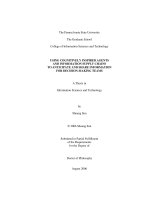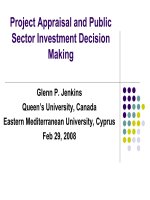using cognitively inspired agents and information supply chains to anticipate and share information for decision making teams(fileminimizer)
Bạn đang xem bản rút gọn của tài liệu. Xem và tải ngay bản đầy đủ của tài liệu tại đây (2.61 MB, 290 trang )
The Pennsylvania State University
The Graduate School
College of Information Sciences and Technology
USING COGNITIVELY INSPIRED AGENTS
AND INFORMATION SUPPLY CHAINS
TO ANTICIPATE AND SHARE INFORMATION
FOR DECISION-MAKING TEAMS
A Thesis in
Information Sciences and Technology
by
Shuang Sun
2006 Shuang Sun
Submitted in Partial Fulfillment
of the Requirements
for the Degree of
Doctor of Philosophy
August 2006
UMI Number: 3231899
3231899
2006
UMI Microform
Copyright
All rights reserved. This microform edition is protected against
unauthorized copying under Title 17, United States Code.
ProQuest Information and Learning Company
300 North Zeeb Road
P.O. Box 1346
Ann Arbor, MI 48106-1346
by ProQuest Information and Learning Company.
ii
The thesis of Shuang Sun was reviewed and approved* by the following:
John Yen
Professor in Charge of College of Information Sciences and Technology
University Professor of Information Sciences and Technology
Thesis Advisor
Chair of Committee
Michael McNeese
Associate Professor of Information Sciences and Technology
Akhil Kumar
Professor of Smeal College of Business
Tracy Mullen
Assistant Professor of Information Sciences and Technology
Madhu Reddy
Assistant Professor of Information Sciences and Technology
Joseph Lambert
Senior Associate Dean
Associate Professor of Information Sciences and Technology
Chair, Graduate Programs Advisory Committee
Head of the College of Information Sciences and Technology
*Signatures are on file in the Graduate School
iii
ABSTRACT
September 11 and hurricane Katrina have shown that timely information is
important not only for disaster prevention but especially valuable in effective disaster
response. From the point of view of information and communication technologies, the
challenge is how to coordinate information sharing effectively among members of a
complex decision-making team (e.g. the first responders for a disaster). A common
difficulty is to provide useful and time-sensitive information to team members quickly
but at the same time not overwhelm them with irrelevant information. This problem has
also been encountered in other application domains that require effective communication
in a team environment: examples include military command and control, heath care, and
global enterprise.
Research in the area of team cognition suggests that anticipating information
needs of other teammates is a key behavior for achieving highly efficient and effective
teamwork. Guided by this finding, a framework of Information Supply Chain (ISC) is
proposed and implemented in this thesis research. ISC contains three novel features.
First, it anticipates information requirements using a cognitively inspired decision model.
Second, it consolidates and prioritizes the information requirements using a novel
planning algorithm. Third, it integrates inference, information seeking, and auction for
satisfying the information requirements. The ISC framework is formalized using existing
agent theories as well as implemented in an agent architecture called R-CAST. The
efficiency and the formation of ISC are evaluated using an experiment in a simulated
“information market”.
This research has made two major contributions in addressing the challenges of
information sharing among decision-making teams. First, more accurate information
needs can be anticipated using a high-level cognitive model of decision-makers. This
avoids “pushing” irrelevant information to a decision-maker, which often leads to
information overload. Second, the cost associated with information seeking and
distributing activities can be greatly reduced because these activities can now be well-
coordinated within the ISC framework. In summary, the work presented in this thesis can
help a human team to make better decisions under time pressure, especially in a
distributed environment where an immense amount of information and knowledge are
scattered among members of the team.
iv
TABLE OF CONTENTS
Chapter 1 Introduction 1
1.1 Research Motivations 2
1.2 Present Models for Information Sharing and Their Limitations 5
1.3 Research Questions 7
1.4 Research Scope 8
1.5 Information Sharing: An Information Usage Perspective 11
1.6 Major Research Results 14
1.7 Thesis Outline 15
Chapter 2 Background 16
2.1 Introduction 16
2.2 Cognitive Models of Decision-making 17
2.2.1 Team Cognitions 18
2.2.2 Decision-making Models 19
2.2.3 Recognition Primed Decision-making Model 19
2.3 Workflow Process Models 22
2.4 Agent Technologies 23
2.4.1 What is Agent? 24
2.4.2 Agent Theories 26
2.4.3 Knowledge Representation 28
2.4.4 Agent Communication 30
2.4.5 Cognitive Architectures 32
2.4.6 Agent Oriented Methodologies 36
2.4.7 Information Agents 38
2.4.7.1 Broker 39
2.4.7.2 Matchmaker 40
2.5 Market and Agents 41
2.5.1 Agent Auctions 41
2.5.2 Contract Net Protocol 42
2.6 Conclusions 43
Chapter 3 Task-Oriented Information Supply Chain Framework 44
3.1 An Overview of the Information Supply Chain (ISC) Framework 44
3.2 Formal Foundations 47
3.2.1 Notations 48
3.2.1.1 Basic Logical and Mathematical Notations: 48
3.2.1.2 Notations for the Information Supply Chain Framework 48
3.2.1.3 Notations about Tasks and Actions 49
3.2.1.4 Notations about Agents 49
3.2.2 Research on Proactive Information Exchange in Agent Teamwork 50
v
3.2.3 Two Fundamental Concepts 51
3.2.3.1 Task 51
3.2.3.2 Information 56
3.2.4 Assumptions 60
3.3 Anticipating Information Needs in Task Contexts 62
3.3.1 Information Need 62
3.3.2 Information Needer 65
3.3.3 Recognize Information Needs 66
3.3.3.1 Anticipating Information Needs 67
3.3.3.2 On-demand Information Needs 69
3.3.3.3 Comparing Anticipating Information Needs with Waiting for
On-demand Needs 70
3.3.4 Satisfying an Information Need 72
3.3.5 Committing to Information Needs 73
3.4 Information Requirement Planning 74
3.4.1 Transforming Information Needs to Information Requirements 75
3.4.2 Consolidate Information Requirements 77
3.4.3 Determine Sources 80
3.4.4 Knowledge-based Information Requirement Decomposition 82
3.4.5 IRP Algorithm 85
3.4.6 Challenges 87
3.4.7 Evaluation of Information Management 88
3.5 Information Supply Chain 91
3.5.1 Information Partner 91
3.5.2 Definition of Information Supply Chain 93
3.5.3 Basic Communication Modes 94
3.5.4 Basic ISC Protocol 97
3.5.5 The Benefits of ISC 99
3.6 Establishing Information Partnership and Forming Information Supply
Chain 102
3.6.1 Extending Contract Net for Information Auction 102
3.6.2 Chain Auction, an Example 105
3.6.3 Bidding Behavior 106
3.6.4 Discussions 107
3.7 Developing ISC Framework from SCM 108
3.7.1 ISC differs from SCM 113
3.7.2 ISC Framework Unifies Existing Methods 114
3.8 Conclusion 115
Chapter 4 Realizing the ISC framework within R-CAST: an Agent Architecture 117
4.1 The R-CAST Architecture 120
4.1.1 Framework 122
4.1.2 Realizing Decision-making Process Model in R-CAST 123
4.1.3 Anticipate Information Needs in R-CAST 125
vi
4.1.4 An Integration Perspective 127
4.1.5 Control and Interface 129
4.2 The R-CAST Components 131
4.2.1 Active Knowledge base 132
4.2.1.1 AKB Key Features 132
4.2.1.2 AKB Syntax 134
4.2.1.3 AKB Interface Functions 137
4.2.2 Process Manager 138
4.2.2.1 Process Manager Key Features 138
4.2.2.2 Process Knowledge Syntax and Characteristic 141
4.2.2.3 Process Manager Interface Functions 145
4.2.3 RPD Decision-maker 146
4.2.3.1 RPD Model design 148
4.2.3.2 Experience Knowledge Syntax 152
4.2.4 Task manager 154
4.2.5 Information Manager 157
4.2.6 Communications Manager 159
4.2.7 Auctioneer 163
4.3 Lessons Learned 165
4.3.1 Configurability Leads to Flexibility 166
4.3.2 Component-based Design Leads to Robustness 167
4.3.3 Two Perspectives to Knowledge Engineering 168
4.3.4 General Implementation Guidelines 170
Chapter 5 Experiments and Results 173
5.1 Experiment 1: Using R-CAST Agents to Model and Assist Decision-
making Tasks 175
5.1.1 Introduction 175
5.1.2 Scenario Design 176
5.1.2.1 The Blue Team 177
5.1.2.2 The Red Team 179
5.1.3 Agent Models 180
5.1.3 Procedure 182
5.1.3.1 The Blue Team Configuration 182
5.1.3.2 The Red Team Configuration and Scenario Settings 186
5.1.3.3 Equipments 186
5.1.4 Results 187
5.1.5 Summary 191
5.2 Experiment 2: Forming Information Supply Chains (ISC) 191
5.2.1 Introduction 192
5.2.2 Color Block Game Settings 193
5.2.2.1 Game Design 193
5.2.2.2 Game Monitor 196
5.2.3 Agent Models 197
vii
5.2.3 Procedure 200
5.2.4 Results 203
5.2.4.1 Result 1: Comparison of Three Information Sharing Models 203
5.2.4.2 Result 2: Forming Information Supply Chains 207
5.2.5 Summary 208
5.3 Conclusion 209
Chapter 6 Conclusions and Future Research 211
6.1 Contributions 212
6.1.1 Proposed a Cognitive Model for Information Push 213
6.1.2 Improved Coordination for Information Sharing Activities 214
6.2 Future Research 216
6.2.1 Long-term Research Problems 216
6.2.2 Develop Combinatorial Auctions for Dependent Information Needs 217
6.2.3 Research in Meta Cognition 218
6.2.4 Realize Learning in R-CAST 220
Bibliography 222
Appendix A Agent Configuration Example 235
Appendix B Knowledge Specification Syntax 239
Appendix C R-CAST Commands 242
Appendix D R-CAST UML Design Diagrams 243
Appendix E DDD Domain Agent Models 257
Appendix F Acronym Index 272
viii
LIST OF FIGURES
Figure 1-1: Timeline of information sharing in emergency response (Chen et al 2005).
3
Figure 1-2: A research roadmap. 9
Figure 1-3: Three perspectives on information sharing 12
Figure 2-1: RPD model (Klein 1989). 20
Figure 2-2: Agent technologies in seven areas. 23
Figure 2-3: W3C semantic Web stack (W3C 2006) 30
Figure 2-4: CAST agent architecture 35
Figure 2-5: An information broker architecture (Martin et al 1997). 39
Figure 3-1: Three stages of a task and their time points 54
Figure 3-2: What information an agent needs v.s. what needs the agent knows 66
Figure 3-3: Information must remain valid 72
Figure 3-4: Multiple seeking plans to cover the duration of a need. 74
Figure 3-5: Basic IRP process 75
Figure 3-6: Overlapping information requirements 78
Figure 3-7: Close (in time) information requirements 78
Figure 3-8: Consolidated information seeking actions 79
Figure 3-9: An agent should plan within its capacity constraints 80
Figure 3-10: Multiple types and recipes of information seeking task. 81
Figure 3-11: A BOM tree and an IDR tree. 83
Figure 3-12: Multiple information fusion rules. 85
ix
Figure 3-13: Information need sets 88
Figure 3-14: An information supply chain 94
Figure 3-15: Three communication models 95
Figure 3-16: Duplicated and circular demands 98
Figure 3-17: Comparing ISC with other communication models 100
Figure 3-18: Information auction protocol. 103
Figure 3-19: An information auction example 105
Figure 3-20: A material supply chain and an information supply chain 109
Figure 3-21: Developing ISC from SCM 110
Figure 3-22: Unifying information sharing methods with the ISC framework. 115
Figure 3-23: 3
rd
party ordering and 3
rd
party inquiry 115
Figure 4-1: Using an agent to model and support a cognitive task 117
Figure 4-2: R-CAST agent and its environment 121
Figure 4-3: R-CAST architectural framework 122
Figure 4-4: R-CAST cognition. 124
Figure 4-5: Managing information requirements 126
Figure 4-6: R-CAST component integration. 129
Figure 4-7: An R-CAST agent interface 130
Figure 4-8: AKB interface. 134
Figure 4-9: Process state transitions. 139
Figure 4-10: PM interface 141
Figure 4-11: Enacting contingencies. 144
Figure 4-12: Computational RPD model 147
x
Figure 4-13: RPD state transitions 148
Figure 4-14: Identifying experiences in R-CAST through RPD. 149
Figure 4-15: A collaborative decision space 150
Figure 4-16: RPD interface 151
Figure 4-17: TM interface 155
Figure 4-18: Overall information management process. 158
Figure 4-19: IM interface 159
Figure 4-20: CM interface. 160
Figure 4-21: Conversation management 161
Figure 4-22: Auction process 164
Figure 4-23: Auctioneer interface 165
Figure 4-24: The Living Lab framework (McNeese et al. 2005). 171
Figure 5-1: A screen shot of S2 interface. 177
Figure 5-2: Team configuration 183
Figure 5-3: Interface for moving pattern inputs 186
Figure 5-4: Performance evaluation 188
Figure 5-5: Variant human performance v.s. stable agent performance 190
Figure 5-6: An IDR in CBG game 194
Figure 5-7: Color block game monitor. 196
Figure 5-8: An ISC in a CBG. 199
Figure 5-9: Three supply models 200
Figure 5-10: Comparing performances of three supply models. 205
Figure 5-11: Comparing average utilizations of three supply models 206
xi
Figure 5-12: Formation of information supply chain. 208
Figure D-1: Whiteboard class diagram 244
Figure D-2: AKB class diagram. 245
Figure D-3: AKB sequential diagram 246
Figure D-4: PM class diagram 247
Figure D-5: PM sequential diagram 248
Figure D-6: RPD class diagram. 249
Figure D-7: RPD sequential diagram 250
Figure D-8: TM class diagram 251
Figure D-9: CM class diagram 252
Figure D-10: CM sequential diagram. 253
Figure D-11: IM class diagram 254
Figure D-12: IM sequential diagram 255
Figure D-13: Auctioneer class diagram 256
xii
LIST OF TABLES
Table 2-1: Background Overview 26
Table 2-2: BDI Interpreter (Rao et al. 1995). 26
Table 2-3: KQML Performative Example (Finin et al. 1994). 31
Table 2-4: MaSE Methodology (Wood 2000) 37
Table 3-1: Comparing the On-demand and Anticipated Needs 72
Table 3-2: Comparing Basic Communication Modes. 97
Table 4-1: Anticipate Information Needs in R-CAST 127
Table 4-2: AKB Knowledge Definition Syntax 135
Table 4-3: AKB interface functions 137
Table 4-4: An Example of Process That Count Numbers 139
Table 4-5: Process Knowledge Syntax. 142
Table 4-6: Experience Knowledge Syntax. 153
Table 4-7: Task Specification Syntax 156
Table 4-8: R-CAST Communication Message Types. 163
Table 5-1: BFA Properties 178
Table 5-2: A Rule Example. 181
Table 5-3: A Plan Example 182
Table 5-4: An Experience Example 182
Table 5-5: Comparing S3 Performance. 187
Table 5-6: Standard Deviation Comparison between Human and Agent S4 Player. 191
Table 5-7: An Example of Agent Capabilities in CBG. 198
xiii
Table 5-8: Parameters Used in a typical CBG 202
Table C-1: R-CAST Commands 242
Table D-1: R-CAST Design UML Overview 243
Table E-1: Overview of the File Names and Purposes 257
xiv
ACKNOWLEDGEMENTS
Many people have played significant roles in the successful completion of this
dissertation research. First, I sincerely thank my adviser, Dr. John Yen, for five years of
support, care, dedication, and guidance. I am very fortunate and grateful to have Dr. Yen
as my mentor. His help will never be forgotten.
I also thank members of my doctoral committee. Dr. Michael McNeese taught me
cognitive science and provided great help on RPD model. Dr. Tracy Mullen worked
closely with me on agent auctions and the trading agent competition. Dr. Akhil Kumar
provided me lots of insights on workflow modeling. Dr. Madhu Reddy guided my writing
and presenting. I appreciate their efforts and constructive suggestions throughout my
doctoral program.
My research benefits from many other faculty members. A special note of
gratitude goes to Dr. Frank Ritter who taught me cognitive modeling and gave me advice
on how to be a professional scholar. I also thank Dr. Peng Liu for giving advice on
research about information security. Dr. Chao-Hsien Chu, in my proposal committee,
also advised me on how to get through stages of my PhD study.
In addition to faculty members, my fellow group-mates also provided inspiration
through countless hours of discussion and debates. I thank Dr. Xiaocong Fan for useful
comments on Chapter 3. I am also thankful for fellow graduate students: Rui Wang, Cong
Chen, Kaivan Kamali, Guruprasad Airy, Shizhuo Zhu, Viswanath Avasarala, Bingjun
Sun, and Po-Chun Chen.
xv
The R-CAST process syntax and the DDD agent adapter are extended from CAST
2.0, designed by Michael Miller. Mathew Davis offered prodigious support in software
development. Professional editing services from Roger Dudik improved the quality of
this thesis. Their help saved my time tremendously and is highly appreciated.
I dedicate this thesis to my family: my parents, my bothers, and finally my wife
Ying. Your love makes my achievement possible and makes my life meaningful.
Chapter 1
Introduction
The crisis of 9/11 and hurricane Katrina has shown that timely information is
important for preventing and responding to disasters. The 9/11 Commission [1] found
that “poor information sharing was the single greatest failure of our government in the
lead-up to the 9/11 attack.” Failure to share information adequately, within and across
agencies, was a significant factor that led to missing opportunities to disrupt the 9/11 plot.
The 9/11 Commission recommended a better information sharing system for connecting
the “dots” and helping intelligence analysis teams to draw on all relevant sources of
information [1].
After four and half years, however, hurricane Katrina revealed this problem once
more. The catastrophic disaster overwhelmed the decision-makers for an initial period of
time. The Committee to investigate the preparation for and response to hurricane Katrina
published a similar finding to the 9/11 Commission that suggested “better information
would have been an optimal weapon against Katrina” [2]. The Committee urged for a
system that can share information “within agencies, across departments, and between
jurisdictions of government” [2]. The system must enable the information to be sent to
the right people at the right time in a secure and efficient fashion.
From the point of view of information and communication technologies, the
challenge is how to coordinate information sharing effectively among members of a
complex decision-making team. A common difficulty is providing useful and time-
2
sensitive information to team members quickly without overwhelming them with
irrelevant information. This problem has also been encountered in other application
domains that require effective communication in a team environment: examples include
military command and control [3], heath care [4, 5], and global enterprise [6, 7].
1.1 Research Motivations
Information and knowledge are distributed across people, systems, and locations.
For example, the contents in a distributed information system may be retained by
professionals specializing in various fields, or distributed via software systems of
different platforms, or stored in hardware media in geological locations farther apart.
Consequently, people must share information effectively in order to support the tasks
they want to accomplish. Sharing information requires effective integration of elemental
steps that include seeking
1
, processing, and distributing useful information in a timely
manner. Recent development of new technologies such as the Web and large-scale
database systems are examples ways to make information sharing easy and efficient. An
unintended consequence of the Web, however, is that the amount of information available
is also increasing at an explosive rate. This creates another key requirement in
information sharing, that is, it has to be accurate so that only the most relevant
information is selected, and efficient so that a large volume of information can be
processed quickly for decision-making.
1
In general, information sharing and information seeking are separate activities. In this thesis, information
sharing refers to any activities related to supporting decision-makers with useful information. Therefore,
information sharing encompasses information seeking.
3
The need for information sharing and the associated challenges for a decision-
making team can be illustrated by an example where decisions have to be made based on
time-sensitive information from multiple sources. Chen et al. [8] analyzed a coordinated
emergency response system where teams of responders are divided into three tiers
according to their dispatch sequence: the 1st tier consists of FBI, police, firefighters, and
emergency medics; the 2nd tier includes hazardous material workers and medical
doctors; and the 3rd tier is made up of security inspectors, waste disposal technicians, and
government agencies. Figure 1-1 shows the timeline for the available information and the
timeline for the needed information during the entire course of an emergency dispatch.
Figure 1-1: Timeline of information sharing in emergency response (Chen et al 2005).
4
Clearly, this diagram shows an uneven distribution of the available information
and the needed information for supporting decision-making. A peak in the timeline of the
available information may represent a situation of information overload or too much
noisy information; whereas a peak in the timeline of the needed information may indicate
that some responders are overwhelmed by information seeking tasks. The lack of needed
information may result from insufficient capability or from lack of resource and
coordination. For example, fire fighters do not have the capability of assessing potential
hazard materials, but they can delegate this task to the hazmat team. However, if the
hazmat team has been assigned to other tasks, then it will be unable to provide the
information in a timely manner. Therefore, resources must be allocated properly to
ensure that time-sensitive information is provided quickly and that coordination of
various tasks is made based on the available resources and anticipated information.
Overloading decision-makers with irrelevant information should also be avoided
because interpreting information consumes time and other resources. Sometimes,
collecting information is less important than interpreting the information with experience
and intuition [9]. For example, sending a book to someone takes only a minute, reading
the book may take days, and fully understanding the content can take a much longer time.
Information overload is partially caused by the volume of available information but, more
importantly, it can also be caused by the limited capacity to process and interpret
information [10].
In summary, both information deficiency and information overload are two key
problems that prevent effective information sharing for collaborative tasks.
5
1.2 Present Models for Information Sharing and Their Limitations
In general, information sharing methods can be categorized into push or pull
models [11, 12]. In a pull model, an information consumer (info-consumer) sends request
to an information provider (info-provider) for the needed information. If the info-provider
has a perfect rating, i.e., does not send irrelevant information, then the information
overload problem can be addressed effectively as long as the info-consumer does not
over-request. However, in some situations, methods based on the pull model can lead to
an information deficiency problem.
First, in a pull method, an info-consumer cannot obtain needed information
because of not knowing either the existence of certain relevant information or who can
provide the information. For example, without a search engine, the Web would not be as
useful as it is. In addition, an info-consumer has to know how to use a search engine and
how to search within a relevant Web site.
Second, an info-consumer may not know the relevance of certain information. As
mentioned before, interpreting information requires knowledge. Without sufficient
knowledge, the info-consumer may not even begin requesting the relevant information.
The 9/11 Commission report [13] shows that the lack of such critical information could
lead to detrimental consequences:
“In the 9/11 story, for example, we sometimes see examples of
information that could be accessed-like the undistributed NSA information
that would have helped identify Nawaf al Hazmi in January 2000. But
someone had to ask for it. In that case, no one did.” (p. 417)
Third, the info-consumer may not know whether a piece of information is up to
date. In dynamic situations, such as an emergency response, a great deal of information is
6
changing constantly, e.g., the status of a fire, the availability of fire engines, and the
progress of a rescue mission. Continuous updating could be one way to solve this
problem; however, it can be impractical because of high communication cost.
Fourth, seeking information requires time and other resources; thus, the info-
consumer may not be able to get information soon enough to make reasonable decisions.
This can cause severe problems in time critical situations. The needed information can be
prepared before carrying out a time critical task. For example, firefighters can get a map
of the emergency site before they get there. If the needed information is changing
frequently, however, the prepared information can become obsolete when used for
making decisions. Therefore, one can only prepare with relatively stable information.
Methods based on the push model have been proposed to address some of the
problems described above. In a push model, the info-provider sends information to the
info-consumer without being asked. A common method is to tailor the contents according
to a consumer profile, which specifies what information the consumer needs and under
what constraints the consumer needs such information. A push method often has the
opposite problems to those in a pull method, namely, irrelevant information is often
provided because it is difficult to update the consumer profile dynamically and
intelligently. For example, suppose a student was taking Class A and purchased two text
books from the online merchant, Amazon. Amazon might continue recommending to the
student books related to Class A, even if the student had already finished the class and the
student’s interests had changed. The above is an example for personalizing product
interests. We can easily extend the concept to personalizing the information needs for
decision-making. In summary, the problem of updating the consumer profile efficiently
7
in a push method often causes the info-provider to send irrelevant information that either
takes away valuable resources for interpreting information or obscuring the mining of
other useful information.
Methods based on a hybrid of the push and pull models have also been used.
Subscription is an example where a consumer is responsible to keep the consumer profile
up to date. Here, the consumer “pulls” the information indirectly by frequently updating
the profile, and the provider “pushes” the information by tailoring according to the
updated profile.
Pull and push models are simple concepts, and can only act as guides in designing
an information system. In complex situations, the direct link between the info-provider
and the info-consumer cannot be established because each may not be aware of the
existence of the other. In this case, an information broker, e.g., a search engine, can help
establish the missing link. Present brokers or search engines can provide the link through
search terms, but they cannot handle dynamic or real-time information sharing that is
needed for a complex decision-making process.
1.3 Research Questions
The above discussion suggests that simple profile-based models are inadequate
for analyzing and solving the information overload and information deficiency problems
in tasks requiring complex decision-making. The key problem is that the consumer
profile is inadequate in describing and modeling information needs in complex processes.
We propose to build a better model to address information sharing problems in a complex
8
environment. For example, the model must provide means (1) to forecast or anticipate
information needs of the info-consumer and (2) to update time-critical information
efficiently, which is accomplished by close integration with the decision-making process
so that flow of information between the consumers (decision-makers) and the providers is
regulated according to the dynamic status of decisions. Additionally, in an information
rich environment, our model must be efficient so that a large volume of information can
be handled. This is especially true in supporting tasks of complex decision-making. The
center piece of our model involves an effective information planning function that is
responsible for coordinating information management activities. This function must be
able to coordinate multiple info-providers and optimize the overall performance of
information seeking activities.
The research described in this thesis is focused on two research questions: 1) how
to accurately anticipate the information needs of decision-making teams in a dynamic
environment? and 2) how to effectively coordinate and improve the efficiency of the
information sharing activities?
1.4 Research Scope
This section briefly introduces my research scope and activities. Figure 1-2
illustrates a roadmap that outlines my research efforts in addressing the information
overload and deficiency problems. Specifically, we would like to build a better model to
handle any dynamic task involving distributed information sources and decision-makers.
This goal may be broken down into 5 steps: (1) analyzing the task, (2) modeling the
9
decision-makers who perform the task, (3) anticipating information needs according to
the model, (4) planning the information seeking activities, and (5) seeking the needed
information.
First, cognitive analysis can be used to understand the task environment, the
performer’s capabilities, the organizational structure, and the knowledge on how a
decision is made. In particular, information that is required must be captured along with
the decision-making process.
Second, cognitive task analysis will lead to a cognitive model
2
, in which task
performers are abstracted by encoding and interpreting their capabilities and knowledge
regarding how to make decisions. The models must be able to simulate collaboration and
2
This thesis uses “cognitive model” to refer to the abstraction of cognition into models and “agent” to refer
the realization of cognitive models through a computational architecture called “agent architecture”.
Furthermore, “cognitive architecture” refers a subset of the agent architecture that simulates cognitive
processes. Agent architecture, however, may contain functions other than those for modeling cognitive
functions: e.g., those for implementing the information management system.
Figure 1-2: A research roadmap.









